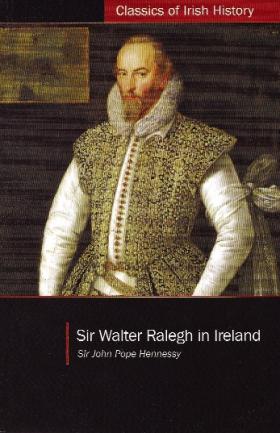Sir Walter Ralegh in Ireland
Published in Book Reviews, Early Modern History (1500–1700), General, Issue 5 (Sep/Oct 2009), Reviews, Volume 17Sir Walter Ralegh in Ireland
Sir John Pope Hennessy
Classics of Irish History series, with introduction by Thomas Herron
(University College Dublin Press, €24. Originally published by Kegan Paul, Trench & Co., London, 1883)
ISBN 9781906359188
 Tom Herron has delivered an enhanced version of this short book by a nineteenth-century Irish politician on a sixteenth-century English adventurer. Though appearing in the ‘Classics of Irish History’ series, it is more a polemic than either a history or a compilation of relevant historical sources.
Tom Herron has delivered an enhanced version of this short book by a nineteenth-century Irish politician on a sixteenth-century English adventurer. Though appearing in the ‘Classics of Irish History’ series, it is more a polemic than either a history or a compilation of relevant historical sources.
Sir Walter Ralegh (1545–1618) was one of the extraordinary characters of the so-called Age of Discovery. The West Country sea dog, having introduced himself to the court by throwing his cape across a puddle for Elizabeth, spent all his cunning to spite the rise of rivals. His North American colony, called Virginia after his patroness’s reputed virtue, proved an expensive and tragic disaster, climaxing in the disappearance of the Roanoke settlers. He is credited with bringing tobacco and potatoes from the New World. He was thrown into the Tower of London for impregnating and secretly marrying the queen’s handmaiden. Later he supported one of James I’s competitors for the English throne and ended up again in the Tower, but this time for far longer. There Ralegh began a History of the World but only got as far as Alexander the Great. James let him out to pursue his dream of discovering El Dorado and settling the Guyanas. He should have stayed up the Orinoco because he was hung at Tyburn soon after he came back for endangering the peace with Spain. The aim of Hennessy’s original work was to introduce and document the Irish aspects of Ralegh’s career. In fact, it tells us more about Sir John than about Sir Walter and more about Anglo-Irish relations in the Victorian period than in the Elizabethan one.
John Pope Hennessy (1834–91) was a star student of the newly established Queen’s College, Cork, from a Catholic middle-class family in the city. Though he took a first in medicine, he went to London to pursue the law and obtained a clerk’s job in Whitehall. The Tories talent-spotted him for the 1859 King’s County by-election, which he duly won as an ‘Irish National Conservative’. When he lost his seat ten years later, he was sent to govern a succession of small colonies—Labuan, the Bahamas, West Africa, Barbados, Hong Kong and Mauritius. He caused havoc in these places and headaches for the colonial office by promoting the locals. By the time he compiled this book, he was ensconced in Myrtle Grove, the house Ralegh had constructed on the dissolved ecclesiastical property of Youghal College. Hennessy saw himself and his generation as not only reversing the wrongs of the past but also altering the trajectory of British imperial policy. In tackling Ralegh and Ireland, he was merely stitching together a series of already published sources so as to engage in a contemporary political debate.
This is why Sir John had it in for James Anthony Froude, the English historian who had been lambasted by other Irishmen. Ironically, what Froude had written about English policies in Ireland during Elizabeth’s reign, and Hennessy quotes some of it, was pretty damning. More correctly and more importantly, Hennessy had it in for Ralegh—for his participation in the Smerwick massacre, for his treacherous arrest of Lord and Lady Roche, for his coveting of the Barrys’ castle and lands, for his proposed assassination of Irish rebel leaders, for his deforestation of the vast Blackwater plantation grant and for maligning the McCarthys when advising Elizabeth. That all this is patently present-minded is clear when Hennessy takes at face value the Irish peasantry’s historic memory of the Elizabethan wars; when he compares Lord Burghley, Elizabeth’s chief minister, to his own patron, Benjamin Disraeli; when he likens the Irish being pushed onto the less fertile uplands by the planters to nineteenth-century schemes to encourage their migration to the colonies; and when he proffers the entirely erroneous opinion that Lord Deputy Perrott’s move to suspend Poyning’s Law was part of a plan to give the Irish self-government.
What Hennessy did get right was the sheer violence and indiscriminate cruelty perpetrated by English captains in the Elizabethan wars. Here he naturally highlights Ralegh’s involvement in the no-quarter given to the surrendering garrison at Smerwick, which Queen Elizabeth subsequently commended as ‘greatly to our liking’. This is a far more honest view than that of some later, allegedly professional, historians. For instance, D. B. Quinn’s Raleigh and the British Empire (London, 1947) exonerates him as following orders at Smerwick (pp 33–4) and describes the devastation, slaughter and famine that form the background to the Munster plantation, and his reward from it, in the passive (pp 129–30) as if no one was responsible! In addition, this politician had a lot more historical sense than some ‘know-nothing’ politicians of this generation. They are happy to commemorate the likes of Ralegh and Drake and apt to neglect not only their victims but also the likes of Sir John Pope Hennessy himself who put them where they are today. HI
Hiram Morgan lectures in history at University College Cork.
















